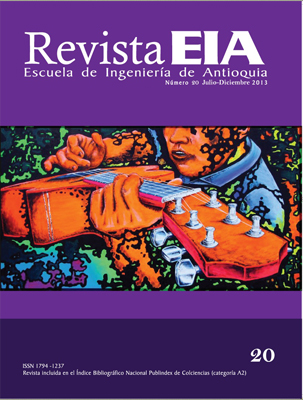Caracterización termodinámica para sistemas de esterificación heterogéneos en destilación reactiva. I. Envolventes reactivas (Thermodynamic characterization for heterogeneous esterification systems in reactive distillation. I. Reactive envelopes)
Caracterización termodinámica para sistemas de esterificación heterogéneos en destilación reactiva. I. Envolventes reactivas (Thermodynamic characterization for heterogeneous esterification systems in reactive distillation. I. Reactive envelopes)


This work is licensed under a Creative Commons Attribution-NonCommercial-NoDerivatives 4.0 International License.
Copyright statement
The authors exclusively assign to the Universidad EIA, with the power to assign to third parties, all the exploitation rights that derive from the works that are accepted for publication in the Revista EIA, as well as in any product derived from it and, in in particular, those of reproduction, distribution, public communication (including interactive making available) and transformation (including adaptation, modification and, where appropriate, translation), for all types of exploitation (by way of example and not limitation : in paper, electronic, online, computer or audiovisual format, as well as in any other format, even for promotional or advertising purposes and / or for the production of derivative products), for a worldwide territorial scope and for the entire duration of the rights provided for in the current published text of the Intellectual Property Law. This assignment will be made by the authors without the right to any type of remuneration or compensation.
Consequently, the author may not publish or disseminate the works that are selected for publication in the Revista EIA, neither totally nor partially, nor authorize their publication to third parties, without the prior express authorization, requested and granted in writing, from the Univeridad EIA.
Show authors biography
Se presenta en este trabajo un enfoque novedoso para el cálculo de las envolventes reactivas líquido – líquido
– vapor (LLV) y líquido – líquido (LL). El principal aporte consiste en indicar explícitamente las manipulaciones necesarias para transformar el cálculo de las binodales en uno de homotopía termodinámica. Así, la solución del problema se traslada a la teoría de los métodos de continuación. Esta perspectiva proporciona adicionalmente un procedimiento para localizar el punto crítico de las mezclas reactivas. Se analizaron dos casos de interés industrial: las binodales reactivas LLV a 101,325 kPa para los sistemas ácido acético + 1-pentanol + agua + n-amilacetato y ácido acético + 3-metil-1- butanol + agua + isoamilacetato. Se encontró que ellas son semejantes a las binodales del tipo I en sistemas ternarios no reactivos. Para el caso del n-amilacetato se ejemplifica la utilidad de estas envolventes en el cálculo y análisis gráfico de un rectificador con varios platos heterogéneos.
Abstract: In this work, a novel approach for the calculation of the reactive liquid – liquid (LL) and vapor – liquid – liquid (VLL) envelopes is proposed. As the main contribution, the way of transforming the binodal lines calculation into the thermodynamic homotopy is explicitly defined. This transforms the problem solution to the theory of the continuation methods. Thus, a method for the localization of the critical point of reactive mixtures is also provided. Two cases of industrial interest are analyzed: the solution of acetic acid + 1-pentanol + water + n-amyl acetate and the solution acetic acid + 3-methyl-1-butanol + water + isoamyl acetate. At 101,325 kPa, the reactive VLL binodal lines are traced. They are similar to nonreactive type I binodal lines in ternary systems. For the n-amyl acetate case, the usefulness of those envelopes is exemplified in the calculation and graphical analysis of a distillation rectification section with multiple heterogeneous trays.
Sumário: Apresenta-se neste trabalho um enfoque novo para o cálculo das envolventes reativas líquido – líquido – vapor (LLV) e líquido – líquido (LL). A principal contribuição consiste em indicar explicitamente as manipulações necessárias para transformar o cálculo das binodais em um cálculo de homotopia termodinâmica. Assim, a solução ao problema traslada-se à teoria dos métodos de continuação. Esta perspectiva proporciona adicionalmente um procedimento para localizar o ponto crítico das misturas reativas. Analisaram-se dois casos de interesse industrial: as binodais reativas LLV a 101,325 kPa para os sistemas ácido etanoico + 1-pentanol + água + n-amilacetato e ácido etanoico + 3-metil-1-butanol + água + isoamilacetato. Encontrou-se que elas são semelhantes ás binodais do tipo I em sistemas ternários não reativos. Para o caso do n-amilacetato exemplifica-se a utilidade destas envolventes no cálculo e análise gráfico dum retificador com vários pratos heterogêneos.
Article visits 370 | PDF visits 183
